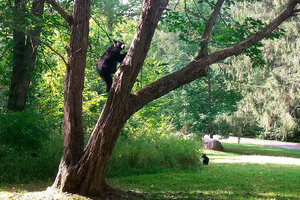How the Parks Service is using DNA evidence to exonerate bears
When bears attack humans, wildlife officials have to put them down. Sometimes, however, the wrong bear ends up in the crosshairs.

A female bear climbs a Chinese chestnut tree in Great Smoky Mountains National Park near Twin Creeks, Tenn. National Park Service rangers are employing modern forensic technology to make sure they don't kill the wrong bear when a human is attacked in the mountains.
Great Smoky Mountains National Park/AP
In the United States’ criminal justice system, defendants are declared innocent until proven guilty.
And rangers with the National Park Service have decided this principle should apply to bears as well.
When park employees and local park visitors learned that multiple bears were killed mistakenly in the last two years at the Great Smokey Mountains National Park, they were devastated. To alleviate these accidental kills, rangers at the 800-square mile park are now using Western Carolina University’s DNA lab to quickly analyze attack sites before killing a suspected bear.
“We never want to kill a bear if we don’t have to,” NPS spokeswoman Dana Soehn told the Associated Press. “It’s the very symbol of the park.”
Previous forensic studies of bear attacks would take weeks to process, far longer than rangers could humanely hold a bear. But easy access to WCU’s DNA lab means faster results for park officials, and the park has established an agreement with the Knoxville Zoo to hold a bear if the results are taking longer than usual.
“One of the reasons why people come to the Smokies is for the opportunity to see a black bear in the wild,” adds Ms. Soehn. “So we know it’s a really special thing for them to see, and we want people to have that chance to see wild bears. But at the same time, we want them to be safe.”
But does pursuing capital punishment for past attackers really help keep people safe?
Chris Servheen, Montana’s grizzly bear recovery coordinator for the US Fish and Wildlife Service, tells The Chicago Tribune that there is a difference between bears with “natural aggression” and “unnatural aggression.”
To begin with, says Mr. Servheen, the bears who attack humans are the outliers. Bears "have every ability to prey on us, but they're wary of us. Ninety-nine point nine percent of bears stay away from people, and that's how they survive," he adds.
As for the offenders, many of the attacks can be attributed to humans, who either approach a bear without caution or knowingly aggravate the animal. But the rest of the guilty bears, those that attack more maliciously, show “unnatural aggression” and will likely attack again.
“They’ve preyed on something that’s vulnerable, they’ve been successful, and they’ve received a reward,” says Servheen. “And we don’t tolerate those cases at all.”
The ethics of bear "court" have been argued by hikers, conservationists, and park visitors alike. When Lance Crosby was killed in Yellowstone Park last year by a mother grizzly bear and her cubs, thousands voiced their opinion: some wanted revenge for Mr. Crosby’s death, while others argued that hikers in national parks enter bears’ territories at their own risk.
And the push for DNA testing by rangers at Great Smokey Mountains National Park comes after a fatal incident in Montana when Brad Treat, a law enforcement officer with the US Forest Service, was killed by a grizzly bear while riding his bike near Glacier National Park Wednesday afternoon.
To avoid bear attacks, experts recommend properly storing food, minimizing body scents, carrying bear or pepper spray, staying on designated paths, and traveling in groups. If a bear crosses your path, never run.
This report contains material from the Associated Press.

